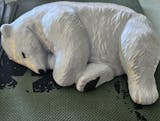A Comprehensive Guide to Choosing the Right FDM Filament for 3D Printing
3D printing has revolutionized the way we bring ideas to life, offering endless possibilities for creators and innovators. Among the various 3D printing technologies, Fused Deposition Modeling (FDM) remains one of the most popular and accessible methods and is the category that Coex 3D specializes in.
You can always reach out to us at Coex 3D for free samples of materials that you may not yet have experience with or simply drop a note in your next order of your "go to" filament and ask for whatever samples you are ready to try. We understand that choosing the right filament type is crucial to achieving optimal results in your 3D prints and we also understand that it can be intimidating to try new things. In this guide, we'll explore the different types of FDM filaments and provide insights into selecting the most suitable one for whatever it is that you are making.
1. PLA (Polylactic Acid): The All-Rounder
PLA is a biodegradable and environmentally friendly filament made from renewable resources like corn starch. It is widely recognized for its ease of use, low cost, and minimal warping during printing. PLA is an excellent choice for beginners and is suitable for a variety of applications, including prototypes, decorative items, and basic functional prints. PLA is by far the most commonly used filament and therefore you will find the largest selection of colors to choose from.. Keep in mind though, PLA may not be the best option for functional applications due to its relatively low melting point and least strength of the materials on this list.
2. ABS (Acrylonitrile Butadiene Styrene): The Durable Workhorse
ABS is known for its strength, durability, and resistance to heat. It is a popular choice for functional prototypes and parts that require resilience to impact and temperature variations. However, ABS tends to emit fumes during printing, necessitating proper ventilation. Additionally, it may be prone to warping, making a heated print bed and an enclosed printer advisable for optimal results.
3. ASA (Acrylonitrile Styrene Acrylate): The Nicer Brother of ABS
ASA is perfect in many ways and is suitable for many different applications. It has a similar chemical makeup to ABS plastic but offers three notable improvements: better mechanical properties, it is naturally UV resistant, and it simply produces amazing finished prints. All of these benefits, along with the fact that it is quite easy to print makes ASA a favorite among many 3D printers.
4. PETG (Polyethylene Terephthalate Glycol): The Tough and Transparent Option
PETG is a versatile filament that combines the best features of PLA and ABS. It offers high strength, durability, and transparency, making it suitable for a wide range of applications, including mechanical parts, containers, and even translucent prints. PETG is less prone to warping than ABS and doesn't emit unpleasant fumes during printing. It also has a higher melting point than PLA, making it a good choice for objects exposed to moderate heat.
5. CoexFlex™ TPE/TPU (Thermoplastic Polyurethane): The Flexible Solution
TPU and TPE are flexible filaments that opens up new possibilities for 3D printing, especially in creating items like phone cases, shoe insoles, and flexible joints. It is resistant to many chemicals, abrasion and is available in a range of hardness ratings or elasticities. Printing with CoexFlex™ TPE and TPU can require specialized settings and equipment. Print speeds generally need to be much slower than other rigid materials and depending on the softness or Shore hardness rating it is recommended that you verify that your printer can extrude the filament before beginning. However, the end result is worth the effort for those seeking flexible and impact-resistant prints. A quick call or email to Coex 3D can save you lots of time down while you learn how to print flexibles.
6. CoexNylex™ Nylon: The High-Performance Choice
Nylon filaments are known for their exceptional strength, heat deflection characteristics, and resistance to wear. They are suitable for industrial applications where high impact resistance and durability are essential. Nylon absorbs moisture, so it's important to store it properly to maintain print quality. Printing with nylon may require a heated chamber to minimize warping, and users should be mindful of its sensitivity to moisture during the printing process.
Selecting the right FDM filament for your 3D printing projects involves considering factors such as material properties, application requirements, and your specific printer's capabilities. Whether you're a beginner or an experienced enthusiast, understanding the characteristics of each filament type will empower you to make informed decisions and achieve successful 3D prints tailored to your needs. All of us here at Coex 3D appreciates how overwhelming it can be to decide on the right filament and we are here to help. Call or email us for advice or to inquire about getting free samples of any of our materials. Experimenting with different filaments will broaden your printing horizons and unlock new possibilities in the ever-evolving world of 3D printing.


